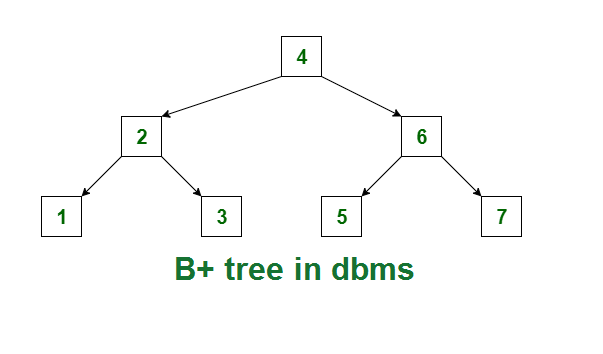What is B+ Tree in DBMS and its structure?

The B+ Tree is a balanced binary search tree. A hierarchical indexing system is used. Actual data references are represented via leaf nodes in the B plus Tree. The B plus Tree maintains uniform heights for all of the leaf nodes. The leaf nodes of the B+ Tree are linked together using a link list. A B+ Tree can therefore support both random and sequential access.
Before comprehending the B+ Tree in DBMS data structure, it is imperative to have a firm understanding of multilevel indexing. As may be seen in the diagram below, multilevel indexing creates the index of indices. Access to data is facilitated and sped up.
B tree and B tree in DBMS
The B tree, a self-balancing tree that facilitates data maintenance and sorting and permits searching, insertions, deletions, and sequential access, is also useful for data maintenance and sorting. On the other hand, the B+ tree is an expansion of the B tree that helps to address the B tree’s fundamental issues.
b+ tree in dbms: B+ Tree Properties
- All of the leaves are the same height.
- The root has at least two children.
- A node can have a minimum of m/2 children and a maximum of m, excluding the root.
- Each node can store a maximum of m – 1 key and a minimum of m/2 – 1 key.
b+ tree in dbms: Pros of B+ Tree
- Records can be retrieved in an equivalent number of disc accesses.
- The height of the B+ Tree is lower and maintains equilibrium compared to the B tree.
- Sequential and direct access can be made to the data stored in a B+ Tree.
- Keys are used for indexing.
- Search queries are quicker because data is only saved on leaf nodes.
B+ tree in DBMS with Examples
- In the B+ Tree in DBMS, each leaf node’s proximity to the root node is the same. The order of the B+ Tree is n, and n is identical for all B+ trees.
- It has an internal node as well as a leaf node.
b+ tree in dbms: Internal Node
- Every internal node in the B+ Tree, excluding the root node, has a minimum of n/2 record pointers.
- Only n pointers can be present in the internal node of the Tree.
Leaf Node
- The leaf node of the B plus tree contains at least n/2 key values and n/2 record references.
- Only n record pointers and n key values are allowed on a leaf node.
- Each leaf node of the B+ Tree contains a block pointer P pointing to the leaf node after it.
Searching Records in B+ Tree
Let’s say we must locate 55 in the B+ Tree in DBMS structure below. We’ll start by getting the leaf node from the intermediary node, which may have a record count of 55.
Therefore, we will find a branch in the intermediary node with 50 to 75 nodes. In the end, we will be sent to the third leaf node. The DBMS will look for 55 using a sequential search in this situation.
Insertion in B+ Tree
Let’s say we want to increase the structure below by 60 records. It will arrive at the third leaf node after 55. We cannot fit 60 into the balanced Tree since one of its leaf nodes has been filled.
In this case, we must break the leaf node to add it to the Tree without affecting the fill factor, balance, or order.
The third leaf node’s values are (50, 55, 60, 65, and 70), and the root node is currently at 50. We will split the leaf node in two in the middle to maintain the balance of the tree. (50, 55) and (60, 65, 70) can be combined into two leaf nodes.
If 50 must branch from these two leaf nodes, the intermediate node cannot do so. Links to a new leaf node will be enabled after it has 60 added to it.
Conclusion
Here you can get the information about the B+ Tree in DMPS, which makes you understand it.
FAQs about b+ tree in dbms
What is the B tree and B+ tree?
B tree is an m-way self-balancing tree in which m determines the tree’s order. B tree is a generalization of the Binary Search tree in which, depending on the value of m, a node may contain more than one key and more than two children. With lower values on the left subtree and higher values on the right subtree, the data is specified in the B tree in a sorted manner.
Because every path from the tree’s root to its leaf is the same length, the B+ tree is often referred to as an advanced self-balanced tree. Since all the leaf nodes are the same length here, they all happen at the same level. It won’t happen that certain leaf nodes appear at level three while others do so at level two.
What does the data structure B and B tree mean?
A self-balancing tree data structure known as a B-tree in computer science preserves sorted data and permits searches, sequential access, insertions, and deletions in logarithmic time. The binary search tree is generalized by the B-tree, which accepts nodes with more than two children.